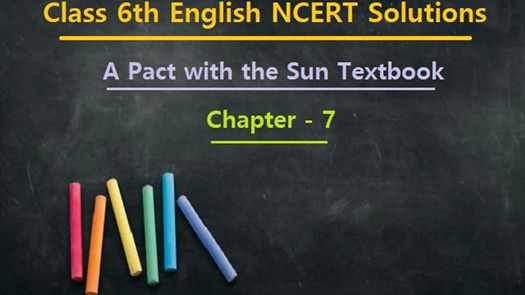
Class 6 English chapter 7- A Pact with the Sun

A Pact with the Sun
“A Pact with the Sun” is a narrative featured in the Class 6 English curriculum that explores the interdependent relationships between nature and humanity, primarily through the symbolic representation of the sun. The story highlights the vital role sunlight plays in sustaining life, fostering themes of environmental stewardship, hope, and resilience. It follows the journey of a young girl named Saeeda, whose unwavering belief in her mother’s recovery serves as a metaphor for the healing power of nature and the human spirit. The chapter is notable not only for its engaging storyline but also for its educational impact, prompting critical thinking and discussions around important moral themes such as responsibility and sacrifice. Educators praise the narrative for its ability to foster students’ analytical skills, making it a valuable resource for teaching literature and writing techniques. As the plot unfolds, it addresses contemporary issues such as environmental neglect and the need for harmony with nature, encouraging readers to reflect on their relationships with the environment and one another. Central to the story’s plot is the climax, which illustrates the dire consequences of neglecting the sun’s importance, leading to a transformative resolution where characters learn to rekindle their bond with nature. This journey emphasizes the significance of nurturing relationships and respecting the delicate balance of life, reinforcing the moral lessons conveyed throughout the narrative. Critics have lauded “A Pact with the Sun” for its compelling themes and its capacity to resonate with young readers, ultimately enriching their emotional and intellectual development.
Plot
The plot of “A Pact with the Sun” unfolds through a series of interconnected events that illustrate the relationship between the sun and nature, as well as the consequences of neglecting this vital connection. It begins with an exposition that introduces the characters and the setting, depicting a vibrant world where the sun plays a crucial role in the cycle of life.
Exposition
The narrative opens by establishing the central theme of interdependence in nature, showcasing how the sun nurtures plants and animals. Characters such as the sun, the plants, and various animals are introduced, revealing their relationships and reliance on one another. This initial setup lays the groundwork for the subsequent conflicts that arise within the story.
Climax
The climax occurs when a significant event disrupts the balance of nature, highlighting the dire need for harmony between the sun and its surroundings. This turning point serves as a moment of realization for the characters, who must confront the repercussions of their previous actions.
Resolution
In the resolution, the narrative ties up loose ends as the characters successfully rekindle their bond with the sun. The story concludes with a renewed appreciation for the sun’s role in sustaining life, reinforcing the theme of interdependence and respect for nature. This resolution not only brings closure to the plot but also imparts a valuable lesson about the importance of environmental stewardship and the consequences of neglect.
Rising Action
As the story progresses, tension builds during the rising action, where the sun’s importance becomes increasingly pronounced. Various events illustrate how neglecting the sun’s role can lead to detrimental effects on the environment. The conflict intensifies as the characters grapple with the implications of taking the sun for granted, leading to a poignant reflection on the consequences of such actions.
Falling Action
Following the climax, the falling action depicts the characters’ responses to the unfolding situation. They begin to understand the importance of the sun and start taking steps to restore balance in their environment. This section illustrates their efforts to mend their relationship with nature, showcasing a collective commitment to nurturing the environment.
Analysis
Overview of Themes
The story “A Pact with the Sun” encapsulates various themes that resonate with the moral and emotional journeys of its characters. Central to the narrative is the theme of hope and resilience, embodied by the young girl Saeeda, whose unwavering faith in her mother’s recovery amid adversity serves as a poignant reminder of the human spirit’s strength. The element of nature, particularly sunlight, is depicted as a healing force, symbolizing both physical and emotional rejuvenation in times of distress.
Character Development
Saeeda’s character development is significant throughout the narrative. Initially, she is portrayed as a helpless child overwhelmed by her mother’s illness. However, as the story progresses, her character evolves into one of agency and determination, showcasing a profound understanding of the importance of care and belief. The transformation reflects broader themes of maturity and responsibility, encouraging readers to recognize the impact of their actions and the importance of nurturing relationships.
Symbolism and Imagery
The sun serves as a crucial symbol in the story, representing hope, vitality, and the promise of recovery. The struggle between sunlight and clouds mirrors the internal struggles faced by Saeeda and her family. This imagery enhances the emotional depth of the narrative, inviting readers to draw connections between the characters’ experiences and the natural world around them. The eventual triumph of sunlight signifies the triumph of hope and belief over despair, reinforcing the moral lessons conveyed throughout the chapter.
Educational Value
In terms of educational impact, the story serves as an effective medium for teaching students about themes of compassion, responsibility, and perseverance. It encourages critical thinking and discussion around the choices characters make and their consequences. Engaging with the text allows students to develop analytical skills as they explore deeper meanings and implications within the narrative, enhancing their understanding of literature and its relation to real-life experiences.
Critical Reception
The chapter “A Pact with the Sun” from the Class 6 English curriculum has garnered positive feedback for its engaging narrative and educational value. Educators and critics alike emphasize the importance of the chapter in fostering students’ analytical and writing skills. The chapter’s structure encourages students to explore thematic elements and character development, making it a useful resource for teaching story writing techniques.
Educational Impact
Teachers have noted that the chapter’s approach to storytelling enhances students’ creativity and critical thinking. The prompts provided in the chapter, such as writing narratives about adventures or mysterious events, allow students to practice crafting engaging plots with clear conflicts and resolutions. Moreover, discussions around the climax of stories, which often involve stakes that resonate with the characters, help students understand narrative tension and its significance in storytelling.
Student Engagement
The chapter has been praised for its ability to move students away from merely seeking “correct” answers towards a more inquisitive mindset. By encouraging observational and analytical skills, the chapter prepares students for deeper literary analysis. This transition from nature-based observations to close reading of texts illustrates the effective scaffolding of analytical writing skills, providing students with a foundation for future academic pursuits.
Themes and Morals
Critics also highlight the chapter’s exploration of significant themes, such as bravery, sacrifice, and the importance of standing up for what is right. These themes resonate well with young readers, allowing them to connect personally with the material and reflect on their own experiences. The moral lessons presented within the narrative structure contribute to a richer learning experience, fostering both emotional and intellectual growth among students.

Contemporary Relevance
Language Skills Development
The chapter “A Pact with the Sun” plays a significant role in enhancing language skills for sixth-grade students. Many learners may not have English as their first language, making NCERT solutions a valuable tool for improving their proficiency. Through exposure to well-constructed sentences, proper grammar, and vocabulary expansion, students can enhance their English language abilities, which is crucial in today’s globalized world.
Critical Thinking and Engagement
Incorporating elements of critical thinking, the chapter encourages students to analyze text, identify themes, evaluate characters’ actions, and reflect on broader consequences, such as environmental issues and human interactions with nature. This engagement fosters a deeper understanding of the material and its relevance to real-world problems, promoting a more thoughtful and analytical approach to learning.
Contextual Learning
“A Pact with the Sun” addresses themes of cultural diversity, social customs, and environmental awareness, making it particularly relevant in contemporary society. By presenting stories that reflect real-life issues—such as wildlife conservation and the importance of respecting diverse cultures—students can connect the lessons from the text to their own lives and communities. This contextual learning enriches their educational experience, allowing them to understand the significance of moral values and social responsibility.
Exam Preparation and Academic Success
Given that NCERT textbooks are extensively utilized for school examinations, the solutions to “A Pact with the Sun” serve as an excellent resource for exam preparation. Students can practice the questions and activities provided in the solutions to assess their understanding and prepare effectively for assessments. This practical approach not only boosts academic performance but also instils a sense of confidence among students as they navigate their educational journey.
Health Literacy and Values Education
The integration of health literacy and moral education within the chapter emphasizes the importance of making informed decisions in life. By discussing social customs and ethical values, the text encourages students to develop into responsible and empathetic individuals. This focus on character-building is essential in today’s society, where understanding and navigating complex social issues is crucial for personal and communal well-being.

FAQs of chapter 7- A Pact with the Sun
1. What is the story A Pact with the Sun about?
A Pact with the Sun is a heartwarming story about a girl named Saeeda and her mother, who is sick. The story highlights the importance of sunlight and fresh air for good health. Saeeda makes a “pact” with the sun, requesting it to shine brightly so her mother can get well by sitting outside in the sun.
2. Who are the main characters in the story?
The main characters are:
- Saeeda: A caring and devoted daughter.
- Saeeda’s mother: A sick woman who needs sunlight and fresh air to recover.
- The Sun: A natural element that plays a symbolic role in Saeeda’s pact.
3. Why was Saeeda’s mother sick?
Saeeda’s mother was suffering from a prolonged illness. Despite various treatments, her health was not improving because she wasn’t getting enough fresh air and sunlight, which were crucial for her recovery.
4. What did the doctor advise Saeeda’s mother to do?
The doctor advised Saeeda’s mother to go outside in the sun and breathe fresh air, as sunlight was important for her recovery. However, the weather had been cloudy for many days, making it difficult for her to follow the advice.
5. How did Saeeda make a pact with the Sun?
Saeeda, noticing her mother’s deteriorating health, went outside one day and made a heartfelt plea to the sun, asking it to shine the next day so her mother could sit in its warmth. The Sun “agreed” to her request and came out brightly the next day.
6. What role did the Sun play in Saeeda’s mother’s recovery?
The Sun played a symbolic and literal role in the recovery. After Saeeda’s plea, the Sun shone brightly, allowing her mother to sit outside, enjoy the warmth, and breathe fresh air. This exposure to sunlight helped her health improve gradually.
7. What is the moral of the story?
The moral of the story is that nature, including sunlight and fresh air, is essential for maintaining good health. It also highlights the power of a child’s love and determination to help their loved ones recover.
8. How did Saeeda feel when the Sun finally shone?
Saeeda felt extremely happy and relieved when the Sun kept its promise. She was overjoyed that her mother could finally sit outside in the warmth, and she hoped it would help her mother recover quickly.
9. Why was the title of the story A Pact with the Sun?
The title reflects the agreement (or pact) that Saeeda symbolically makes with the Sun, asking it to come out and shine for her mother’s well-being. The “pact” symbolizes Saeeda’s hope and determination to ensure her mother gets better.
10. What lesson does the story teach about family and care?
The story teaches that family members, especially children, can play a significant role in caring for their loved ones. It shows the power of compassion, hope, and how even simple actions (like wishing for sunlight) can lead to positive outcomes.
Also Visit: Readspot


